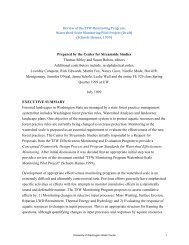Copyright 2012 Aileen M. Echiverri-Cohen - University of Washington
Copyright 2012 Aileen M. Echiverri-Cohen - University of Washington
Copyright 2012 Aileen M. Echiverri-Cohen - University of Washington
Create successful ePaper yourself
Turn your PDF publications into a flip-book with our unique Google optimized e-Paper software.
attentional inhibitory functioning with PTSD treatment. Alternatively, the PPI paradigm showed<br />
that better inhibitory functioning, albeit at a trend level, was associated with better treatment<br />
response, pointing to a potential biomarker for treatment response. Finally, among the individual<br />
difference factors, old age contributed to slower improvements in inhibitory functioning on AB,<br />
suggesting modulations in attentional inhibitory processes are less likely in older individuals.<br />
Differential modulation in fundamental attentional inhibitory processes by treatment<br />
responders suggests differential specificity in how PE and SSRIs normalize inhibitory processes.<br />
Individuals who showed more symptom improvements with PE showed faster improvement in<br />
inhibitory processes from pre- to post-treatment on a key inhibitory lag <strong>of</strong> AB, suggesting greater<br />
improvements in temporal processing across time. In contrast, with sertraline, individuals who<br />
showed more symptom improvement in PTSD symptoms made slower changes in inhibitory<br />
processes from pre- to post-treatment, indicating less improvement in temporal attention over the<br />
course <strong>of</strong> treatment. Further, there was a large effect for this interaction. This potential<br />
differential mechanism <strong>of</strong> treatment response between PE and SER was specific to lag 3 which<br />
places the most stress on temporal attention when close proximity <strong>of</strong> irrelevant distracters inhibit<br />
processing <strong>of</strong> relevant stimuli in a rapid visual stream (Olivier et al., 2008). When trying to<br />
understand AB effects, AB is one <strong>of</strong> many executive functioning tasks where individuals with<br />
PTSD show impairment in redirecting attention in the presence <strong>of</strong> distracters. Deficient<br />
inhibition <strong>of</strong> relevant and irrelevant stimuli may underlie these deficits through a process where<br />
relevant and irrelevant stimuli are simultaneously activated, which in turn, increases the<br />
likelihood <strong>of</strong> retrieval interference and retrieval failures (Vasterling et al., 1998). Further,<br />
difficulties in differentiating relevant from irrelevant information may contribute to<br />
understanding reexperiencing and hyperarousal symptoms in PTSD. Indeed, cognitive intrusions,<br />
41

















